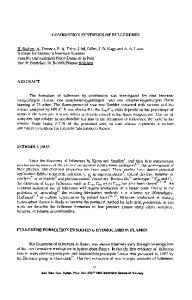Combustion synthesis of HfB 2 -Al composites
- PDF / 1,606,487 Bytes
- 11 Pages / 612 x 792 pts (letter) Page_size
- 63 Downloads / 469 Views
.
INTRODUCTION
THIS is the second of three articles concerned with the effect of gravity on the combustion synthesis (SHS) of metal matrix composites (MMCs).[1,2,3] The Al-HfB2 MMC system was selected since a large volume of low specific gravity liquid Al matrix and a fine, solid, high specific gravity HfB2 ceramic are produced in situ within the overall SHS reaction. This Al-HfB2 system complements the high specific gravity (Ni3Ti)–low specific gravity (TiB2), Ni3TiTiB2 (SHS) reaction system discussed in the first article.[1] The combustion system of single phase compounds has been studied extensively.[4–7] Normally, such combustion reactions are initiated at the melting point of the less refractory element such as aluminum in the synthesis of Ni-Al[8] and Ti-Al,[9] titanium in Ti-C,[10] or the formation of eutectic liquid phase as in the case of Ni-Ti.[11] Subsequently, the melt spreads and wets the solid particles due to the capillary force. The self-sustaining combustion is then initiated between the liquid and solid particles at the combustion front. The combustion reaction is carried out in a narrow region in the combustion front known as the combustion zone. The structure of the combustion zone, which can be determined by temperature profile analysis, can be categorized by two types, namely, ‘‘equilibrium’’ and ‘‘nonequilibrium’’ as defined by Merzhanov.[4] The difference between the two is that for ‘‘equilibrium combustion,’’ cooling of newly formed products follows the main reaction zone, whereas for the ‘‘nonequilibrium combustion,’’ there is further structural relaxing after the main reaction. For both cases, combustion zones can be divided into three regions: preflame, main reaction, and after burning. Normally, there is only a single exothermic peak in the entire combustion zone. H.C. YI, Engineer, and J.Y. GUIGNE´, President, are with Guigne´ International Ltd., Paradise, NF, Canada A1L 1C1. T.C. WOODGER, Graduate Student, and J.J. MOORE, Professor and Head, are with the Center for the Commercial Application of Combustion in Space (CCACS), Colorado School of Mines, Golden, CO 80401. Manuscript submitted January 8, 1997. METALLURGICAL AND MATERIALS TRANSACTIONS B
The SHS of both single compounds and multiphase composite materials can involve multiple steps. In the SHS of Ti3Al(Nb)-TiB from elements, it was postulated that Ti3Al was the first phase to form, which then triggered the TiB reaction.[8] In the SHS of the TiC-Al2O3-Al system from TiO2, Al, and C, reduction of TiO2 by Al was believed to be the first reaction.[12] A similar reaction mechanism was also proposed for the synthesis of Ni3Al-TiB2 from its elements.[14] However, these assumptions have not been confirmed by temperature profile measurements or thermal analysis. Processing of composite materials, either MMCs or ceramic matrix composites (CMCs), by means of SHS has gained wide interest. While there has been no difficulty in producing CMCs using SHS, synthesizing MMCs using SHS is difficult since such reactions are normally less exotherm
Data Loading...











